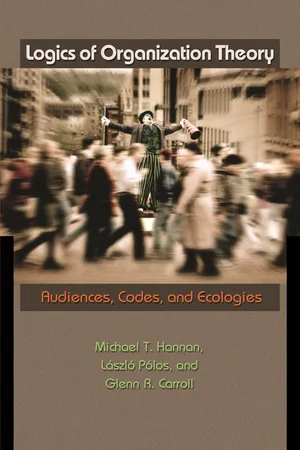
Logics of Organization Theory
Audiences, Codes, and Ecologies
- 384 pages
- English
- PDF
- Available on iOS & Android
Logics of Organization Theory
Audiences, Codes, and Ecologies
About this book
Building theories of organizations is challenging: theories are partial and "folk" categories are fuzzy. The commonly used tools--first-order logic and its foundational set theory--are ill-suited for handling these complications. Here, three leading authorities rethink organization theory. Logics of Organization Theory sets forth and applies a new language for theory building based on a nonmonotonic logic and fuzzy set theory. In doing so, not only does it mark a major advance in organizational theory, but it also draws lessons for theory building elsewhere in the social sciences.
Organizational research typically analyzes organizations in categories such as "bank," "hospital," or "university." These categories have been treated as crisp analytical constructs designed by researchers. But sociologists increasingly view categories as constructed by audiences. This book builds on cognitive psychology and anthropology to develop an audience-based theory of organizational categories. It applies this framework and the new language of theory building to organizational ecology. It reconstructs and integrates four central theory fragments, and in so doing reveals unexpected connections and new insights.
Frequently asked questions
- Essential is ideal for learners and professionals who enjoy exploring a wide range of subjects. Access the Essential Library with 800,000+ trusted titles and best-sellers across business, personal growth, and the humanities. Includes unlimited reading time and Standard Read Aloud voice.
- Complete: Perfect for advanced learners and researchers needing full, unrestricted access. Unlock 1.4M+ books across hundreds of subjects, including academic and specialized titles. The Complete Plan also includes advanced features like Premium Read Aloud and Research Assistant.
Please note we cannot support devices running on iOS 13 and Android 7 or earlier. Learn more about using the app.
Information
Table of contents
- Cover
- Title Page
- Copyright Page
- Table of Contents
- Preface
- Chapter 1. Language Matters
- Part 1. Audiences, Producers, and Codes
- Chapter 2. Clusters and Labels
- Chapter 3. Types and Categories
- Chapter 4. Forms and Populations
- Chapter 5. Identity and Audience
- Part 2. Nonmonotonic Reasoning: Age Dependence
- Chapter 6. A Nonmonotonic Logic
- Chapter 7. Integrating Theories of Age Dependence
- Part 3. Ecological Niches
- Chapter 8. Niches and Audiences
- Chapter 9. Niches and Competitors
- Chapter 10. Resource Partitioning
- Part 4. Organizational Change
- Chapter 11. Cascading Change
- Chapter 12. Opacity and Asperity
- Chapter 13. Niche Expansion
- Chapter 14. Conclusions
- Appendix A. Glossary of Theoretical Terms
- Appendix B. Glossary of Symbols
- Appendix C. Some Elementary First-Order Logic
- Appendix D. Notation for Monotonic Functions
- Appendix E. The Modal Language of Codes
- Bibliography
- Index